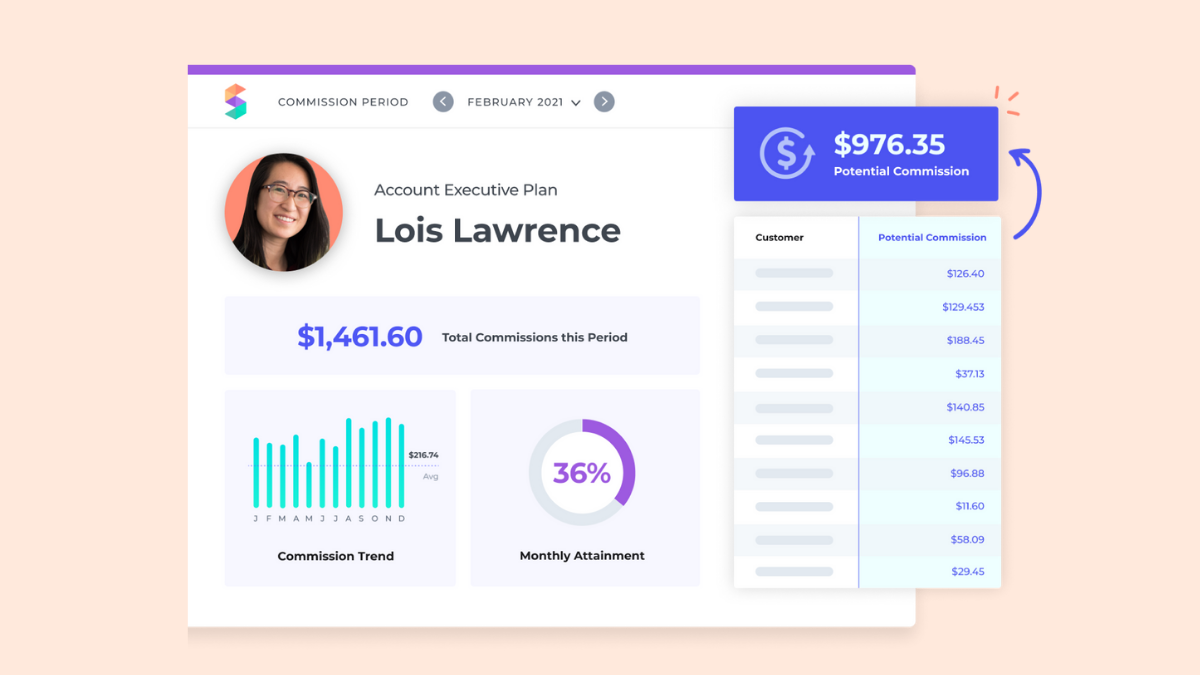Comp plan design can feel like mental gymnastics. Not only do you have to build the actual commission plans, but you also have to communicate how it all works in a way that motivates your reps to close more deals.
The issue is, actual design is rarely a part of the commission planning process. The psychology behind compensation plan design usually focuses on behaviors to encourage or discourage. But we often fail to bring psychology into how we’re actually sharing this information with our sales teams.
How our brains actually operate— with a propensity for visual information— gets lost in the shuffle. As a result, reps are handed hefty plan docs that make their eyes glaze over — hardly an ideal seller experience.
At the same time, alternative means of representing and distributing information— like data visualization— is often reserved for analysts or decision makers, not the reps themselves. This is a huge missed opportunity. Data visualization is one of the most powerful tools at your disposal when it comes to creating compensation plans that motivate employees.
In this quick guide to data visualization in sales, you’ll learn:
- Why lack of data visualization in traditional compensation processes is hurting you and your reps
- Why data visualization matters in sales
- And, data visualization tips you can use right away to immediately increase the impact of your sales incentive programs— without having to overhaul your entire system
Ready? Let’s dive in!
Why traditional compensation processes are failing you
Managing commission spreadsheets or using spreadsheet-based legacy software makes it difficult to effectively motivate reps, even if the plan itself is genius. Here’s why:
Traditional processes have fallen behind modern day selling and science.
When spreadsheets first appeared in the 1970’s, selling was almost unrecognizable from present day. Think about it. Half a century ago:
- Reps would travel thousands of miles per year and pitch out of their briefcase, often using product catalogs.
- Reps could find prospects in a physical phonebook.
- The Internet was still in its infancy, and complex SaaS products (with equally complex contracts) were nonexistent.
- Sales commission was simple and straightforward.
While selling has transformed over the past 50-something years, the spreadsheet has remained fundamentally unchanged. That’s why it continually struggles to manage intricate, nuanced comp plans and accurately process the vast amounts of commission data required for modern day sales teams to operate.
Primitive underlying technology aside, traditional comp processes also suffer from limited data visualization capabilities. Subsequently, comp plans and commission statements are typically formatted as plain text documents. However, 90% of information transferred to the brain is visual (source). That means spreadsheet-based comp management isn’t merely at odds with modern day selling, but modern day science.
Reps don’t understand their comp plans.
What do plain text documents, spreadsheets, and spreadsheet-based legacy systems have in common? They make it difficult for reps to understand what they’re getting paid. In fact, only 24% of sellers can easily calculate their total variable compensation (source).
It’s not just because the plans themselves are complex. It’s also due to the format in which the information is shared— like those 20-page plan documents written in exhaustive detail. Important for legal coverage? Absolutely. But this also frequently fails to demystify compensation for reps. Commission statements can be perplexing as well, especially if they’re just a glorified list of numbers, and reps can’t see where the money actually came from.
All this means the sophisticated psychology behind comp plan design— how to encourage or discourage specific behaviors— is missing a critical component: the way our brains actually process information that drives those behaviors in the first place.
When reps don’t understand comp plans, motivation and productivity take a hit.
Reps spend only 37% of their time on revenue-generating activities (source). This makes sense though, when you consider how many reps struggle to understand how they’ll be compensated for their efforts. When reps have to decode their comp plans and commission statements, they’re essentially doing the heavy lifting to motivate themselves.
Enter shadow accounting– accounting done in spreadsheets to independently track opportunities and hours spent double checking calculations, comparing notes with other reps, or flagging potential errors. This time doesn’t just eat away at daily productivity, but can also trigger a negative cycle, where the decreased focus on selling leads to fewer deals and smaller payouts— tanking motivation even further.
Why data visualization matters in sales
We already know spreadsheets and bulky documents aren’t the most effective ways to motivate sales reps. So what does work? It’s simple: Data visualization.
Scientifically speaking, there are three main reasons why data visualization is so impactful in sales:
Brains are wired to process images faster.
The rapid speed at which we can understand images makes data visualization a natural fit for fast-paced sales teams:
- Brains can process an image in just 13 milliseconds (source)
- Brains process visuals 60,000x faster than text (source)
- Teams using visualization are 28% more likely to find information on time (source)
According to Mary Potter, Professor of Brain and Cognitive Sciences at MIT, “The fact that you can do that at these high speeds indicates to us that what vision does is find concepts. That’s what the brain is doing all day long— trying to understand what we’re looking at.” (source)
Data visualization is intended to help the brain quickly process complex information. On sales teams, this translates into a deeper understanding of complex plans and improved visibility in a fraction of the time it takes with outdated tools and processes.
Brains are wired to process images better.
As far as our brains are concerned, images have a lot more staying power than plain text:
- People remember 80% of what they see, compared to just 20% of what they read and 10% of what they hear (source)
- People can remember more than 2,000 images with at least 90% accuracy over several days (source)
- The average worker can increase comprehension and retention by 50% using visuals (source)
Sales reps often need to process, retain, and contextualize a lot of information to understand their compensation— role, territory, product hierarchy, sales cycle complexity, type of contract, and infinite other variables can impact their pay.
However, if information is disjointed or shared in a way our brains aren’t inclined to retain, the end result is confusion. Why do you think you have to keep answering the same questions every pay cycle?
Data visualization, alternatively, can help illustrate even the most intricate commission structures in a format our brains are more likely to understand and remember.
Brains are wired to search for patterns.
Our brains’ fondness for visuals is basically a response to information overload– we’re wired to make sense of information by seeking out patterns:
- The ability to spot existing or emerging patterns is one of the most if not the most critical skill in decision-making, though we’re mostly unaware that we do it all the time (source).
- The brain has 2% of the body’s weight and uses 20% of the body’s energy. Thinking uses energy, any optimizing system will take steps to reduce that drag on the system– i.e. pattern seeking (source).
- The human brain undergoes physical changes when it’s seeking out patterns. One study found that just looking at a piece of artwork increases blood flow to the brain by as much as 10%. Why? We’re subconsciously discerning familiarity and meaning from patterns, abstract forms, and incomplete information (source).
Data visualization breaks down information in recognizable patterns— the same patterns our brains are continually searching for to process, understand, and contextualize the vast amounts of data we encounter on any given day.
Using data visualization to communicate and report on sales compensation is, well, a no-brainer. You’ll not only save your reps time and resources, but you’ll also help preserve their brain power for more important activities.
Data visualization tips to improve incentive programs immediately
This isn’t a call for you to ditch your entire compensation strategy. However, you can still benefit from data visualization principles with the following best practices:
Make sure compensation plans are visually clear.
Our brains are more likely to pay attention to visual information. High quality infographics, for example, are 30x more likely to be read than plain text (source). You don’t need to create a bunch of infographics for your reps, but there are steps you can take to make your comp plans more digestible.
Clarify lengthy plan documents with a simple table of contents, a tldr, or a desktop version containing only the most critical parts.
Make sure compensation plans are credible.
Our brains trust information more when it’s processed visually— visual and verbal communication combined have a 2.5X higher credibility rate than verbal communication on its own (source).
To increase credibility with your plan documents, include sample calculations to illustrate hypothetical payouts.
Adopt a “data visualization mentality”— even if you don’t have any visuals
Data visualization ultimately boils down to simplifying information so it’s easier to process. This could be as straightforward as creating a FAQ for each comp plan— so reps can view important details in a question and answer format— or taking screenshots of a specific spreadsheet formula to help someone understand how their pay was calculated.
Final Thoughts & Long Term Data Visualization Solutions
Stop and take inventory of your comp management processes, and look to see where your team is struggling the most. From there, you can identify and prioritize areas for improvement, and start introducing data visualization in smaller steps.
If you’ve already taken smaller steps to improve communication around your comp plans but still struggle with confused, unhappy sales reps, it might be time to look into a long term solution.
A sales commission platform like Spiff can completely transform your sales organization by providing reps visibility into the commission process in a way that’s easy for them to understand. Our easy-to-use interface and the way we use visuals to enhance commission reports is a game changer for sales organizations.

About Spiff
Spiff is a new class of software that creates trust across organizations by delivering real-time automation of commission calculations and motivates teams to drive top-line growth. With a combination of an intuitive UI, real-time visibility, and seamless integrations into current systems, Spiff is the first choice among high-growth businesses. Spiff’s sales commission software enables finance and sales operations teams to self-manage complex incentive compensation plans and provides transparency for sales teams.






